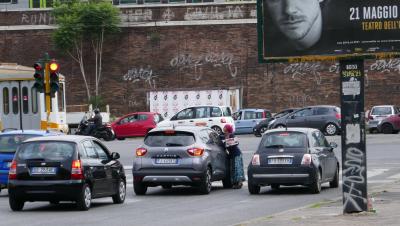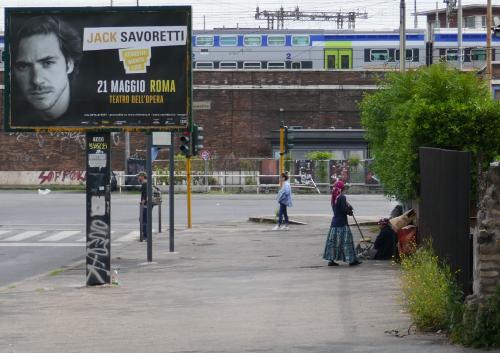Exclusive Investigation -- The child slaves of Rome

ROME – Vans, cars and motorcycles are speeding though the arches of the aqueduct at Piazza Porta Maggiore in the heart of the Eternal City. They arrive in waves from the centre and come to a grinding halt at the traffic lights before heading for the periphery. In the opposite direction, completing a counter-clockwise whirlpool, another wave splits between left, under the arches, for the centre and right, below the tunnel, for San Lorenzo. The traffic is roaring. Car horns blow. Suddenly, a sharp whistle sounds. A regional train crawls through the arches of the century-old monument.
In the early heat of a late May day, while refugees are idling at the tram stops, tourists admire the majestic junction of Rome’s former water supply system.
At the traffic lights, a young woman and two adolescent boys are trudging in between the vehicles. The woman wears a long, colourful dress and ditto headscarf. The elder boy has dyed the top of his hair rusty the way it is fashionable among Roma youth. As soon as the vehicles halt, the woman shouts at the boys. Each boy approaches a vehicle, pointing a brush at the driver. When the driver does not explicitly refuse, the youngster cleans the windscreen. These children are Italy’s “bambini argati”.
Beside the traffic lights, leaning against a concrete wall, three elders sit on cardboard boxes that are spread out on the pavement. They have covered their legs and waists with blankets. Each time the traffic lights turn green, the young woman walks over to the threesome.
At the other side of the eight-lane road, in the shadow of the monument, sit a middle-aged couple and an elder man. They are eating and drinking in the high weeds. Next to them stands a baby buggy. A large box containing a fan sticks out of it. All the time, the adults watch the boys work. Two destitute families trying to get by?
The word “argat” is Slavic for “sold to work”. A child who begs and who is supervised by an adult rarely is the adult’s own. Destitute families sell or rent out their children to compatriots abroad. There is a real contract, albeit not a written one, between the child’s biological parents and its ‘adoptive’ parents. In Italy, these children are to beg, play music for money, collect iron, pickpocket or burgle. The parents back home receive a monthly fee as soon as the child makes money. Sometimes the cession spans the entire childhood and extends into adolescence.
Around noon, the couple stands up. The woman, who wears a traditional dress and headscarf, uses her mobile phone to make a phone call. She is worried: the boys’ hit rate is rather low. Roman drivers are familiar with this type of begging: statistics from a helpline show that, in Lazio, child begging is twice as high as the national average. The drivers gesticulate firmly to indicate the boys they are not to touch their car. The man empties the baby buggy: the couple will go through the neighbourhood’s rubbish bins. The elder man, however, stays on the piazza keeping an eye on the boys. The boys’ dark complexion contrasts with the couple’s, which is noticeably lighter.
The term “bambini argati” was first used in Milan in 1984. Four Albanian adults stood trial: the foursome had been selling children to gangs who operated all over Italy. “Uncle Asim commutes to Yugoslavia through the woods, taking children from Yugoslavia to our camp,” a 10 year-old boy told the Italian police. “He stays in Yugoslavia for a month and then returns to the camp with children I think are used for begging. Many of them are taken outside the camp on random days and return either in the evening or the following day, handing over to my father the money they have earned.” In the homeland, such gangs put up to 3 year-olds under heavy sleep-inducing drugs and lay them on the pavement, force 4 to 7 year-olds to drink shampoo so that stomach aches make them look starving and assign older children auxiliary begging activities such as washing windscreens.
“Ho fame. Grazie,” ("I'm hungry. Thanks") reads the worn cardboard the young woman shows every driver. Except for stints in tourist spots, the “bambini argati” work in in the periphery, on parking places of shopping malls, and in smaller cities, like Rome’s satellite city Latina. In Italy, any child, native as well as foreign, found on the streets and thought to be abandoned will be taken to a first-level shelter (“Centro pronto intervento minori”) operated by an NGO. From there, the child will be either transferred to a government-operated shelter or reunited with the family. In 2003, the City of Rome and UNICEF opened “Il centro di contrasto alla mendicità infantile”. A villa in the North of Rome provided shelter to abandoned children. It operated a helpline for citizens to signal children who were begging in the streets.
The centre was unique in Italy. Between 2003 and 2006, it treated 1.859 children: 80% of them were from Romania and 19% from ex-Yugoslavia. Staff managed to foil the sale of a newborn and discovered an extensive paedophile network. The UN considered the centre a best practice and its concept was to be copied in other regions. Yet, in the first semester of 2008, the centre had to close its doors because of a lack of budget.
The same year the centre was closed, a study revealed that, in Lazio, at least eight thousand children were begging in the streets. Following cases in Rome, Naples, Turin, Florence, Caserta and Foggia that were similar to the Milan one, Italy developed a legal and policy framework to provide and protect children that probably is the most comprehensive in the whole of Europe.
In Italy, trafficking that involves children is considered as an aggravating circumstance to the general offence of trafficking in human beings and trafficking for the purpose of labour exploitation is addressed and governed by the same articles as trafficking for sexual exploitation. The law distinguishes three offences: article 600 on slavery or servitude, article 601 on human trafficking and article 602 on slave trade. Yet, the line between these offences is fine. Moreover, the law does not clearly define the offences. This leads to incoherent application of the legislation. In 2008 for example, police officers intercepted a woman on two occasions. Each time, the woman was sitting on the pavement with a baby in her arms. A four year-old boy was with her. At the first interception, the boy had been begging for four hours without sitting down or eating and in plain winter, was wearing only pants and a t-shirt. He handed his earnings to the woman. At the second interception, the woman was handing money to compatriots of hers. The authorities took the woman to court. In first instance, the woman was found guilty of enslavement and child abuse and was sentenced to six years prison. Upon appeal, this sentence was reduced to five years prison. Upon further appeal, the court judged the woman begged to provide for her family, and only a couple of hours per day, and found her guilty only of child abuse.
The two boys and the young woman carry on through the sudden rain showers. They slip between the accelerating cars and avoid the motorini that zoom by. They work steadily. Each time the traffic lights turn red, they approach the first car of the road section and work their way towards the back of the row. When the vehicles shoot off, they rinse their brush in a bucket that stands beside the signalling house.
The Milan trial revealed that, inside the gypsy camps, children who have been sold or rented out are called labourers. They have to get up before dawn to fetch firewood and wash the vans. They do not have contact with other children in the camp. When the trial made the headlines, Roma associations claimed that only “cergars”, a traditional, Muslim clan of tent dwellers from Albania, would practice child trafficking. One couple had even sold its own child in order to buy a child that was more adept at stealing. Yet, the handicapped beggars, the burglars and the pickpockets whose earnings fund ornate palaces in respectively Romania, Serbia and Bosnia, prove that this practice is not exclusive to Muslim tent dwellers from Albania.
A World Bank study found that the parents back home receive approximately one-fourth to one-fifth of the child’s earnings. Yet, often the family does not receive as much as promised. Or nothing at all: the middlemen add costs for the trip, lodging etc. In Baranzate, a pickpocketing gang obliged the children to gamble in the camp so they would perpetuate their debt.
Close observation reveals a hierarchy: the woman commands the older boy who, in his turn, commands the younger boy. During the Baranzate trial of 35 adults who had enslaved 144 children, Judge Corrado Carnevali called the victims “children without a future”. The children had been reluctant to talk to the police. Some kept silent out of fear for repression from their aggressors whereas others refused to talk because they aspired to become patrons themselves.
In the early evening, when traffic on Via Prenestina and Via Casilina is slowing down, the troupe leaves the square. Child beggars often suffer multiple forms of exploitation: for instance begging by day, prostituting themselves by night. The only visible signs of the troupe’s activity are plastic bags and bottles, paper tissues and wrappings on the pavement and in the greenery. The “bambini argati” are without identity: many Roma children from Albania and former Yugoslavia as well as those who are born in Italy do not have a birth certificate. The “gazda” moves his “argati” often so that they would not bond with locals who may help the children. The troupe’s van stands parked in Via Casilina. It heads off for the “tangenziale”. Tomorrow the band will be at another crossroad in another neighbourhood, or city.



